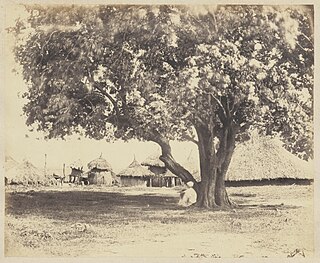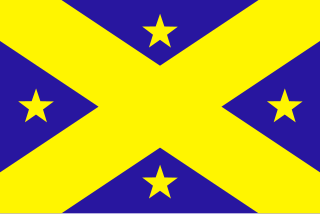
Equatoria is the southernmost region of South Sudan, along the upper reaches of the White Nile and the border between South Sudan and Uganda. Juba, the national capital and the largest city in South Sudan, is located in Equatoria. Originally a province of Anglo-Egyptian Sudan, it also contained most of northern parts of present-day Uganda, including Lake Albert and West Nile. It was an idealistic effort to create a model state in the interior of Africa that never consisted of more than a handful of adventurers and soldiers in isolated outposts.

Gondokoro island is located in Central Equatoria. The island was a trading-station on the east bank of the White Nile in Southern Sudan, 1,200 kilometres (750 mi) south of Khartoum. Its importance lay in the fact that it was within a few kilometres of the limit of navigability of the Nile from Khartoum upstream. From this point the journey south to Uganda was continued overland.

Central Equatoria is a state in South Sudan. With an area of 43,033 square kilometres (16,615 sq mi), it is the smallest of the original South Sudanese states. Its previous name was Bahr al-Jabal, named after a tributary of the White Nile that flows through the state. It was renamed Central Equatoria in the first Interim Legislative Assembly on 1 April 2005 under the government of Southern Sudan. Central Equatoria seceded from Sudan as part of the Republic of South Sudan on 9 July 2011. The state's capital, Juba, is also the national capital of South Sudan. On October 2, 2015, the state was split into three states: Jubek, Terekeka, and Yei River. The state of Central Equatoria was re-established by a peace agreement signed on 22 February 2020.

The Lado Enclave was a leased territory administered by the Congo Free State and later by the Belgian Congo that existed from 1894 until 1910, situated on the west bank of the Upper Nile in what is now South Sudan and northwest Uganda. Its capital was the town of Lado.

Rokon is a city in the Juba County, Central Equatoria of South Sudan, part of the region of Equatoria. The priest and scholar Ezra Baya Lawiri was buried there following his death in 1991.

Juba is the capital and largest city of South Sudan. The city is situated on the White Nile and also serves as the capital of the Central Equatoria State. It is the most recently declared national capital and had a population of 525,953 in 2017. It has an area of 52 km2 (20 sq mi), with the metropolitan area covering 336 km2 (130 sq mi).
Rejaf, also Rajāf or Rageef, is a community in Central Equatoria in South Sudan, on the west bank of the White Nile.

Juba County is an administrative area in Central Equatoria state, South Sudan. It is the largest county in Central Equatoria and one of the largest in the region of Equatoria. Its county seat is Juba, the national capital of the South Sudan.

Mongalla or Mangalla is a Payam in Juba County, Central Equatoria State in South Sudan, on the east side of the Bahr al Jebel or White Nile river. It lies about 75 km by road northeast of Juba. The towns of Terekeka and Bor lie downstream, north of Mongalla.
Kiro was a colonial post in what is now the Central Equatoria State of South Sudan on the west side of the Bahr al Jebel or White Nile river. It was in part of the Lado enclave.

Amadi State was a state in South Sudan that existed between 2 October 2015 and 22 February 2020. Amadi state formed from Western Equatoria state on 2 October 2015, following a decree that established the state along with 27 other states. It was located in the Equatoria region. Amadi State bordered Eastern Lakes State, Jubek State, Maridi State, Terekeka State, Western Lakes State, Yei River State.

Terekeka State was a state in South Sudan that existed between 2 October 2015 and 22 February 2020. It was located in the Equatoria region and it bordered Amadi, Eastern Lakes, Imatong, Jonglei, and Jubek. It has an estimated population of 176,030 in 2014, and the capital and largest city of the state is Terekeka, South Sudan.

Yei River State was a state in South Sudan that existed from 2 October 2015 to 22 February 2020, when it became a part of the state of Central Equatoria.
Augustino Jadalla Wani ; born Augustino Jada Wani, is a South Sudanese politician who served as the deputy minister of interior and wildlife conservation (2013–2015) and later as the governor of the now defunct Jubek State.(2015–2020)
Rija is a small settlement in Juba County, Central Equatoria, South Sudan, about 6 km east of Dollo and 60 km west and 15 km south of the state capital Juba.
Lado Koda is a small town in Terekeka County, Central Equatoria, South Sudan, about 2 km northwest of the Koda River outlet on the White Nile, 8 km southwest of Mongalla, 14 km north by northeast of Luala, and 36 km from the state capital Juba and 60 km west and 15 km south of the state capital Juba. It is located just north of the Koda River's floodplain, on the new Juba-Terekeka road.
The Koda River, locally called Khor Koda, is a seasonal tributary of the White Nile in the state of Jubek, South Sudan.
Wulikare is a small settlement in Juba County, Central Equatoria, South Sudan, about 0.5 km south of the Koda River, 4 km west of Ludo Kenyi, 14 km from the Jebel Lado mountain, 37 km southwest of Mongalla, and 29 km from the state capital Juba It is located near on the road from Juba to Buko, Tijor, and Rokon.
The Canadian Economic Development Assistance for South Sudan (CEDASS) is a privately funded Canadian registered charity and a registered NGO in South Sudan It was founded in 2005 by British entrepreneur David Tennant and other Canadian philanthropists.
Mount Lado or Jebel Lado is an isolated hillock in Central Equatoria, South Sudan, about 13 km northwest of the White Nile and 28 km due north of the national capital Juba. The mountain was also called Mount Nyerkenyi.










